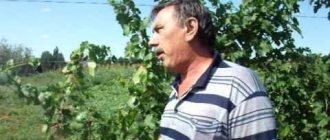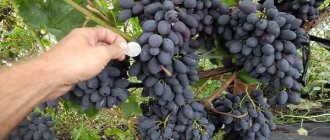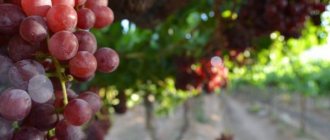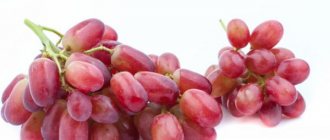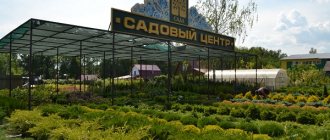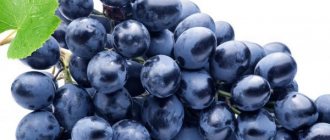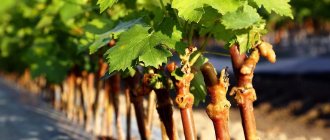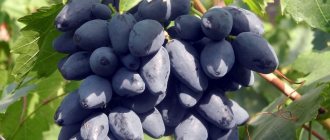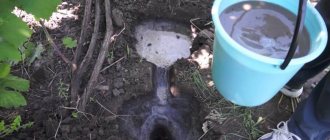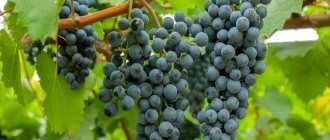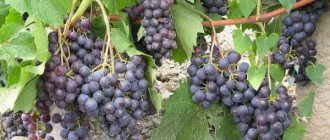Grapes are a berry that many gardeners, both beginners and experienced, want or dream of having on their country plot. When choosing a varietal variety, winegrowers and breeders are advised to pay attention to the ripening period, the color of the berries and the type of application.
In accordance with these parameters, among the various types of grapes, varieties of early, medium and late ripeness are distinguished. According to taste and visual qualities, the varieties are pink, blue, dark or green, and according to their intended purpose there are table, dessert and industrial varieties. A special type that requires consideration is early express grapes, namely its main characteristics and growing conditions.
When choosing a varietal variety, winegrowers and breeders advise paying attention to the ripening period, the color of the berries and the type of application.
Express grape variety.
The Express grape variety is a Far Eastern variety selected by Adelii Ivanovich Vaskovsky. Parents (Amursky x Early Magarach). Synonyms - Vaskovsky Express, Early Express. Universal purpose, very early, ripening at the end of August, in our Tver region September 1-5. In the Primorsky Territory, ripening at the end of August - or beginning of September. Frost resistance is high -30˚С, -32 gr. With , but a covering variety in our Tver and Moscow region conditions, otherwise freezing is possible. And it is also necessary to provide shelter in the conditions of Primorye, because there, despite the latitude of Crimea, it is also a zone of risky farming.
The bunch is winged, not dense, medium loose, weight 250 - 500g. The berry is black, high sugar content, 22-26%, acid up to 9 g/l. The taste is pleasant, very harmonious. Resistance to diseases - mildew and anthracnose is average, it is necessary to carry out treatments. In our area, little disease so far , although in some regions, incl. in the Far East, it is affected by mildew. But so far, despite the wet year, the Vaskovsky Express grape variety suffered from mildew no more than others. Basically, the tops of the leaves that have grown after treatments with systemic agents are affected. The vine usually ripens well. Rooting of cuttings is also good.
Below is a photo of the leaf, crown and flower brush photo source
.
Express grape variety. The leaves are large and glossy. Vigorous bush. During the growing season, it requires timely fertilizing and mandatory rationing of inflorescences and clusters of grapes, since there are 4-6 inflorescences on the shoot. The variety is prone to overload. It is necessary to leave 1-2 clusters on the vine. When overloaded, the berries become smaller, crumble, and the clusters become looser, “disheveled”,
After a year of overload, the Express grape variety may need to be restored to avoid becoming more susceptible to disease and less productive.
To speed up the entry into fruiting, you can graft Express onto Alpha or Lydia. It’s easier to graft Black into Green or Green into Green in the summer. Do this when the green shoot becomes a little woody and is ready for grafting, at a height of about 1 meter. Next year you need to dig up the grafting site and transfer Express to your roots. Transferring to its roots will save the bush from possible incompatibility between the rootstock and scion.
Express grapes refer to wine grape varieties with early ripening berries. His parent is a Far Eastern amateur - breeder Adely Vaskovsky.
Early Express can be called the younger brother of the Express variety. The grapes are suitable for zoning in northern latitudes. The description of the characteristics of the variety states that it can withstand temperatures down to minus 32 degrees and is highly resistant to diseases.
Early express on the bush in July
In central Russia it is grown as a non-covered crop. In wet weather, only two preventive treatments are sufficient.
Plant care tips
When growing Express Early grapes, standard agrotechnical rules for caring for the crop are followed.
See also
Description and characteristics of the Nastya grape variety, pros and cons, cultivation rulesRead
Watering
Freshly planted grapes should be watered frequently (1-2 times a week, depending on the amount of precipitation). Mature vines are watered as needed (2-3 times per season). In summer, the grapes are watered after the ovary has formed.
Top dressing
It is not recommended to feed seedlings in the first two years. In the third year they begin to apply fertilizers. In spring, urea or saltpeter is used. After flowering, mixtures of potassium, phosphorus, and wood ash are added.
Trimming
The main care procedure is timely pruning of the vine. In the first year, shoots that have grown to a height of 150-160 cm are pinched. The next year, in the fall, two powerful vines are left, and weak shoots are cut out. The variety is fertile - 6-8 clusters can be tied on one branch. However, it is not recommended to leave more than 1-2, otherwise the berries will become smaller and crumble.
A Brief History of Grapes
The common name of the grapevine (Vitis vinifera L.), its description was found in the works of ancient scientists. Originates from the Caucasus and Iran, from where it spread throughout Europe and other continents. This is one of the oldest cultivated plants. Known 7000 -9000 years ago.
The most valuable raw material obtained from grapes is the fruit, which is widely used in the food industry.
Early black grapes Express are suitable for making wine
The fruits are eaten raw, in the form of juice, raisins. They are also used to produce wine, a drink that has been part of the diet of many peoples for many thousands of years.
About the benefits of express early grapes
The fruits of this variety contain polyphenolic compounds (flavonoids, procyanidins, etc.), which have a positive effect on the cardiovascular system and prevent atherosclerosis, coronary disease and heart attacks.
The beneficial components of grapes contribute to the accumulation of “good” cholesterol and the oxidation and reduction of the amount of “bad” cholesterol.
In addition, berries have antioxidant, anti-inflammatory and antiangiogenic (vasodilation) effects. Prevents the development of cancer cells. The only caution concerns the limited consumption of grapes for people with obesity and diabetes due to the high calorie content of the berries (100 g contains 70 kcal).
Thus, early express grapes have excellent taste properties, and the growing conditions are quite simple due to the variety’s unpretentiousness and disease resistance. Frost resistance is high, which sets this variety apart from many others. In addition, growing grapes on a trellis or in gazebos, along fences, will not only delight you with a delicious harvest, but will also decorate your garden and create a beautiful, cozy, shady atmosphere.
Characteristics of the variety
The grape variety is unpretentious and adapts well to external conditions, therefore it is widely used and is popular among gardeners. Sweet, with a high sugar content (25-28%), it has a specific taste that many people like. Acid content 6-9 g/l. Wines from Express grapes:
- beautifully painted;
- well structured;
- have an unusually intense aroma of dark berries;
- pleasant spicy aroma.
Presumably, the variety was obtained as a result of crossing the Ranniy Maragach and Amursky varieties.
A bunch of grapes Express early medium and large size
This grape makes good cognac.
Description
The early Express berry is small (2-4 g), round in shape, clusters weigh 250-350 grams. The color is dark blue with a black tint. The variety is very prolific, which should be taken into account when forming a bush. The description of the variety indicates that 5-6 inflorescences can simultaneously form on one shoot.
Bushes with unusually beautiful leaves, but due to their strong growth they require a lot of space.
Early express on the bush won a photo competition for the most beautiful bunches
A SEVERAL MORE PROMISING WINE VARIETIES FOR MIDDLE RUSSIA AND THE NORTH
Closely behind the top dozen above are the varieties Far Eastern Novikova and Olenevsky black A.I. Potapenko. Sometimes the new is the well-forgotten old.
Wine grape variety Far Eastern (Novikov selection, Russia)
Early, resistant to frost -28 °C and mildew. The clusters are medium. The berry is almost black, tasty (chokeberry and blueberry tones; perhaps a faint nutmeg).
Productivity when irrigated is high.
Dry and semi-sweet wine – mono and sepage.
Wine grape variety Olenyevsky black (from the first Amur hybrids selected by A.I. Potapenko)
Early, sweet, stable, productive, good for wine. The bush is vigorous, so it can be used for arches and arbors.
Of the new varieties that have not yet begun to bear fruit, there is great hope for Cabernet Jura , a promising variety by Valentin Blattner (Switzerland).
But for your vineyard, the final choice of varieties is yours. Our beloved grapes are so unique and flexible that they can grow almost anywhere a person is willing to plant and love them. Just as wine grapes have been growing for many years in our Tver grape garden, so they can grow in your vineyard.
Popular varieties
Early and super early grape varieties:
| 1. Libya |
Characteristics:
- the variety is resistant to diseases and weather conditions;
- the ripening period lasts 105 days from the moment of bud formation;
- the plant has a powerful root system with a rapidly developing vine;
- the cluster is large, up to 26 cm long, the fruits are slightly oval, pink in color;
- the weight of each grape is 10 - 12 g;
- the pulp has an excellent taste, moderately dense with barely noticeable skin and a rich aroma of nutmeg;
- sugar content 20%, acidity 6 – 7 g/l;
- tolerates frosts down to -21C;
- agrotechnical requirements are simple;
- suitable for cultivation in the Krasnodar, Primorsky, Stavropol territories, the Volga region and the North Caucasus
Main characteristics
| Purpose of the variety | wine |
| Acidity of the variety | 5 g/l |
| Sugar content of the variety | 15 — 20 % |
| Bunch shape | cylindrical |
| Bunch weight | 120 - 150 g |
| Berries shape | round |
| Berry color | dark pink |
| Berry size | 5 g |
| Taste | subtle isabelle aroma |
| Frost resistance | up to -26 degrees |
| Ripening period | 90 - 100 days |
| Yield per bush | 1.6 - 1.7 bunches |
Frost resistance is quite high. Without shelter, grape bushes can withstand up to -26 degrees. The sugar content of the variety is 15-20%. Acidity – 5 g/l. The average weight of berries is 5 grams. The mass of the bunch is 120-150 grams. The variety is used fresh or for making wine. The shape of the berries is round, the size of the brush is large.
The yield of the bush is on average 1.6 - 1.7 bunches. The load on one bush is 30-40 buds.
In the spring, we remove the covering material and apply fertilizing
- We make holes . When the air temperature stabilizes from -5C, you can gradually open the film by making several holes in it. A little later, when the threat of frost has passed, the shelter can be completely removed. It is advisable to treat the plants with Epin solution, which will protect the grapes from return frosts for 1.5 weeks.
- Getting rid of stagnant water. To prevent the root system from rotting from excess moisture as a result of melting snow, it is necessary to completely scoop out the resulting puddle. Or dig a ditch so that the water drains on its own.
- We do the pruning. Use pruning shears to remove any dead or damaged stems.
- We tie up the vines. After awakening, the plants will begin to actively grow, so they should be tied to a support.
- We examine the plants. The bush must be carefully examined to exclude fungal and viral diseases. If a disease is detected, you need to urgently treat the plant or get rid of it so that the virus is not transmitted to neighboring specimens.
- Treat with Nitrafen. To prevent dangerous diseases and protect against insect pests, you must spray the bush with a solution: 200 g of Nitrafen per bucket of water.
- We add fertilizer. As a top dressing, it is necessary to use a complex fertilizer, but without the following microelements: Kemira and Nitrophoska. First dig up the soil around the bush, and then water it with this liquid. This will help raise the temperature in the soil.
- Water the grapes. If the vine is not yet 3 years old, it must be watered using a plastic tube buried in the ground. For irrigation, use warm water (40 liters) mixed with wood ash (500 g). The frequency of watering is carried out in stages: 1 time - after wintering, as soon as the shelter is removed, 2 times - a week before flowering, 3 times - when the plant fades, 4 times - a week before wintering.
Fertilizers for express early grapes: description
To increase the yield and resistance of grapes, the following means are used:
"Neoron" is a remedy for spider mites. It has a broad effect, destroys pests at different phases (larvae and adults). It should be processed in dry weather (at least 5 hours before predicted precipitation). The protection is active for up to 25 days. It is important to remember that the product cannot be applied later than 45 days before harvest.
"Mikom Reacom" is a complex of microfertilizers that improves the general condition of the grape bush.
The proportions should be as follows: for spraying, 25 g of the product is mixed in 10 liters of water. For root feeding (watering), take 25 g of the drug per 200 liters of water, watering one bush once - 10 liters, then after about 15 days the treatment is repeated.
“Stroba” is a fungicide that helps in the fight against mildew, oidium and other fungal infections.
"Ridomil Gold MC" is a systemic contact agent that eliminates mildew. The proportion is as follows: 10 g of the drug per 4 liters.
Iron sulfate can destroy fungal infections of shoots
Iron sulfate can destroy fungal infections of shoots. It can be used from the beginning of the season. For 10 liters of water there are 300 g of vitriol. It can also be used to treat grapes after winter, pinching and will reduce the damage caused by plant pests.
The drug "Cantus" has an effect against rot, especially in conditions of excessive soil dampness.
The use of foliar fertilizers begins in the second half of May. In this case, it is correct to carry out treatment with these means no later than 20 days before the stage of fruit ripening. To increase the effectiveness of these measures, you can add urea, a nitrogen-containing fertilizer that improves the growth and vitality of grape bushes. The proportion may be as follows: take 40 g of the drug per 10 liters of water. After 2 weeks, a repeat event is held.
If the berries are cracked due to rainy weather or frost, you can fertilize the bushes with phosphorus-potassium products (for example, monoammonium phosphate or ash).
Moreover, after harvesting, growth regulators (gibberellin) or magnesium salts can be applied foliarly.
In summer we pinch the vines and spray the bushes
- We carry out pinching. The vine should not exceed 1.7 meters in length, so it must be pruned (pinched). Also remove all emerging stepsons, which will take a lot of strength from the plant. Otherwise, the stems will grow weakened and the clusters small.
- We inspect the plant daily. In order to notice insect pests or dangerous diseases in advance, you need to regularly inspect the bush.
- We add fertilizer. The first fertilizing should be done in June. To do this, prepare a solution with Ridomil, following the instructions on the package. The early prepared remedy Fufanon is added to it. Both compositions are thoroughly mixed and sprayed on the plant. Repeated treatment is carried out in July.
Briefly about the problem
Why is so much attention nowadays paid to the cultivation of certain agricultural crops and so much money and labor is spent on breeding optimally adapted varieties for the climatic and other characteristics of the regions? In particular, the promotion of a heat-loving and light-loving crop - grapes - is becoming increasingly important to the Urals, Siberia and the Primorsky Territory. This phenomenon is directly related to the outstanding qualities of the grape berry.
Introducing a sufficient amount of grapes or its products into the menu can literally be called the elixir of youth
- The noble vine has been cultivated by mankind since time immemorial, and today it is difficult to say when our distant ancestor first received the aromatic sweet and sour juice from a bunch of amber berries. For thousands of years, the excellent taste, dietary and therapeutic properties of the berry have been highly valued, which allows the grape to be a leader among the rest of the numerous fruits and berries.
- Eating grapes in one form or another - fresh, as a menu addition, dried or dried in the form of raisins, juices, jelly or a certain amount of wine daily allows a person to receive easily digestible natural sugars, the required amount of organic acids, such as free tartaric components, lemon, apple, oxalic, formic and others.
- Today, physiologists, microbiologists and nutritionists have determined the highest value of grapes due to the unique content of a complex of vitamins - A, B, B2, B6, C and P, folic acid, minerals and microelements. From the point of view of usefulness, it is difficult for a person to overestimate the importance of receiving the required amount of chemical elements into the body. This is a certain level of potassium, sodium, phosphorus, silicon, iron, magnesium, aluminum, manganese, bromine, boron, iodine, zinc, sulfur.
- Such a volume of substances is extremely important for humans. Thanks to the composition of grape juice balanced by nature itself, the level of human working capacity increases, the possibility of blockage of blood vessels is prevented due to deposits of toxins and harmful substances in the bloodstream.
- Introducing a sufficient amount of grapes or their products into the menu can literally be called the elixir of youth. Active influence on hormonal processes and activity, improvement of metabolism made it possible to use grapes and grape juice as a unique natural preparation. Traditionally, doctors recommend grape juice for young children, elderly people, rehabilitation after surgery and serious illnesses.
- Grape berries are an ideal product in terms of the balance of substances, allowing you to thoroughly cleanse the body and give the skin an excellent color, a fresh, healthy, blooming appearance. Consumption of the gifts of the vine allows you to radically increase the content of vitamins C and B in the blood.
- Grape seed processing products - essential oils and many other highly valuable derivatives are now widely used in the production of pharmacological, medicinal, cosmetic, decorative products for the care of the face, hands, and hair. History confirms that the juice and crushed seeds were an excellent means of the beauty industry in Ancient Greece and Rome.
In the fall we feed the bush and cover it for the winter
- We fertilize with organic matter. After the end of fruiting, the plant becomes very depleted and weakens. Therefore, at this time it is necessary to apply organic fertilizer by mixing it with wood ash. You also need to treat it with protective agents against pathogenic microorganisms and harmful insects.
- We do the pruning. As soon as the plant is completely bare of leaves, it must be carefully trimmed of unnecessary shoots and the vine shortened. But this must be done before the first frost, since then the wood of the vine will become brittle.
- Cover with spruce branches. The base of the vine should be sprinkled high with soil. Bend the top to the soil surface and cover with a layer of spruce branches. Or use a special covering material. And with the arrival of winter, cover it with snow.
| 2. Adler | |
| 3. Veles | |
| 4. Julian | |
| 5. Delight | |
| 6. Nadezhda Early | |
| 7. Moscow | |
| 8. Bashkir | |
| 9. Firstborn (Bulgaria) | |
| 10. Vaskovsky Express (early) |
Express early grapes: treatment with drugs at different growth phases
- The “calm” stage (before winter). When the air temperature is 10°C. Iron sulfate can be used as an antiseptic (300 g of product per 10-liter bucket). The procedure consists of two stages: before sheltering for the winter, then after the kidneys awaken. Otherwise the kidneys may be damaged.
- Stage of kidney swelling. Using a variety of means, insects that overwinter in the kidneys or in the soil (for example, spider mites) are destroyed.
- Stage of appearance of the first leaves (4–5 leaves). Shoots should be treated for fungal infections. It is important to remember the average temperature and weather in which diseases appeared in the previous season.
- Flowering stage. The treatment is carried out before and after flowering (4-5 days) in two stages: once the disease may not be eliminated immediately, which will reduce the yield and viability of the plant.
- The growth stage of berries (peas). The use of universal preparations against fungi and insects.
Beneficial components of grapes contribute to the accumulation of “good” cholesterol - Stage of fruit coloring. Complex treatment with drugs against pests and diseases. It is not recommended to use systemic means, but only contact ones. Toxicity when choosing insecticides should be no higher than 3 points.
- After the harvest. The goal is to reduce the spread of fungal spores and infections. The procedures will increase the stability and viability of grape shoots next season.
Characteristics of the “super extra” grape variety: description, photos and reviews about it
| Selection | "talisman", "cardinal" and a mixture of pollen of other species |
| Ripening period | Early |
| Bunch weight | 500-800 g. |
| Berry weight | 7-12 years |
| Productivity | 25 kg per bush |
| Taste | Moderately sweet |
| Bush | Vigorous |
| Frost resistance | Up to -25°C. |
| Disease resistance | Average |
“Super Extra” is a grape variety that is rapidly gaining popularity among winegrowers and amateur gardeners. This is explained not only by the many positive characteristics of the variety, such as resistance to frost and ripening time, but also by the high commercial qualities of the crop and the pleasant taste of the berries.
Advantages and disadvantages
When deciding to start growing “super extra” grapes, you should familiarize yourself in advance with the list of its positive and negative characteristics.
The main advantages of the variety for gardeners and winegrowers include:
- Large fruit.
- Resistant to frost and other adverse weather conditions.
- Good transportability and keeping quality.
- Abundant yield.
- Immunity to diseases characteristic of the culture.
Also, the indisputable advantage of the variety is that the berries on the bushes ripen evenly and have a pleasant taste.
The “super extra” has few disadvantages, but there are still some disadvantages:
- The probability of the formation of berries of different sizes on a bunch.
- Dense and tough skin.
- Tendency to phylloxera.
In addition, the bushes need timely pruning, aimed primarily at normalizing the yield. Otherwise, not only the quality of the berries deteriorates, but also their ripening period increases.
Origin
“Super Extra” grapes are the result of breeding work by amateur gardener E. G. Pavlovsky, obtained by crossing the varieties “Talisman”, “Cardinal” and a mixture of pollen of other species. Originator: Federal State Budgetary Educational Institution of Higher Education “Kuban State Agrarian University named after. I. T. Trubilina."
Parents of “super extra” - “talisman” and “cardinal”
Main characteristics
“Super Extra” is a table grape variety whose appearance is very similar to the “Arcadia” variety. It is also worth noting such super-early varieties as “transformation”, “Veles” and “rumba”.
Maturation period and class
This is a very early ripening variety that requires only 95-105 days to fully ripen the fruit. The exact time when the crop is ready for harvest depends on the climate and weather conditions of the growing region. As a rule, the harvest time falls on the last days of July or the beginning of August.
Bush
The “super extra” grape bushes are powerful, vigorous, young shoots are light green, old shoots are light brown.
The leaves are rich green in color, medium in size, round in shape, five- or three-lobed with weak dissection, jagged edges and light cobwebby pubescence on the underside, the surface is smooth or reticulate-wrinkled. The flowers are bisexual, the degree of pollination is average.
Bunches and berries
The brushes are large, loose, cylindrical-conical in shape, weighing on average 500-800 g , but larger specimens are found, weighing up to 1.6 kg.
The berries are large, ovoid, slightly elongated, grow up to 3.5 cm in length and 2.5 cm in width and weigh on average from 7 to 12 g. The fruits are covered with a durable and rather hard green-yellow skin, which by the time of ripening takes on an amber hue.
The pulp is fleshy, crispy, the juice is colorless, there are 2-3 medium-sized seeds inside . Sugar content when fully ripened is 17.4%, acidity is 6.1 g/l.
Taste
The taste of the fruit is simple, pleasant, moderately sweet, but they do not have a bright and refined aroma.
Productivity
The bushes begin to bear fruit from the second year after planting. With proper care, up to 25 kg of grapes can be harvested from 1 bush , and the yield from 1 hectare of land reaches 169 centners.
Comparison with analogues
“Super Extra” is far from the only table grape variety with early ripening. However, thanks to its characteristics, it can compete with other varieties.
| Sign | Variety | ||||
| Super extra | Karmacode | Russian Korinka | New gift to Zaporozhye | Blagovest | |
| Ripening period | 95-105 days | 110-125 days | 110-115 days | 110-125 days | 110-115 days |
| Frost resistance | Up to -25 °C | Up to -22 °C | Up to -22…-28 °C | Up to -24 °C | Up to -23 °C |
| Yield per bush | Up to 25 kg | About 25 kg | Up to 12 kg | Up to 30 kg | 6-8 kg |
| Bunches | 500-800 g | 300-500 g | 180-200 g | From 800 g to 1.1 kg | From 900 g to 1.2 kg |
| Taste | Simple, moderately sweet | Tart with a slight nutmeg aroma | Rich, without extraneous flavors | Sweetish with apple aftertaste | Sweet with notes of duchess and aroma of nutmeg |
| Color | Green-yellow with amber tint | Red-violet | Golden with soft pink blush | Greenish white | Green with a yellowish tint and an amber tan |
| Disease resistance | Average | Average | Average | High | Average |
| Shelf life | A few months | Up to 3 months | Until autumn on the bush | Up to 3 months | A few months |
| Sugar content | 17,40% | 16-22% | 22-23% | 16-19% | Up to 22% |
| Acidity | 6.1 g/l | 9 g/l | 5-6 g/l | 5-6 g/l | About 8 g/l |
Features of cultivation
In general, the requirements for planting and caring for “super extra” grapes almost completely coincide with the requirements of other super early varieties. However, some nuances should still be taken into account.
Landing
A favorable period for planting grapes is considered to be spring or autumn , and in both cases there are pros and cons.
In the case of spring planting, young plants do not have to immediately winter in the open ground and they have time to take root and stock up on nutrients. In this case, it is necessary to strictly observe the planting date - by planting seedlings earlier or later than the optimal time, you can slow down their development.
Autumn planting takes longer; seedlings quickly grow in spring without wasting time on adaptation, and during autumn and winter days with above-zero temperatures, the root mass of plants increases. However, there is a risk of losing seedlings at sub-zero temperatures if covering material is not used.
“Super Extra” is unpretentious in soil composition, but prefers light, moist, nutritious soil with good aeration. You can learn about the ideal soil for grapes from a separate article.
The place should be bright. Despite the fact that the bushes of this grape can develop and bear fruit in shaded areas, the abundance of sunlight still has a more favorable effect on their development and the quality and abundance of the harvest. also need to ensure that the place is protected from wind and drafts, the distance between bushes is at least 1.5 m, and between rows - 3 m .
Watering and fertilizing
Grapes need moderate watering - prolonged drought negatively affects the yield and quality of the fruit, and excessive soil moisture leads to cracking of the berries and provokes rotting of the root system.
In the absence of rain, you need to water the plants once every 2 weeks, pouring 15-20 liters of water under each bush. To retain moisture in the soil after watering, mulch it with sawdust or moss.
In the spring, during the growth of green mass, it is necessary to feed the grapes with nitrogen-containing fertilizers, for example, humus or compost. It is also useful in the spring to place wood ash containing potassium and phosphorus in holes dug near the bushes.
Before the flowering period and at the beginning of the growth and formation of berries, the bushes need potassium, phosphorus and calcium, which are contained in mineral fertilizers. In this case, foliar feeding is appropriate.
Trimming
“Super extra” grape bushes are prone to strong growth and the formation of many stepsons on the shoots , which reduces yield. Therefore, it is necessary to regularly carry out pinching so that the nodes of the vine remain with 2 stepsons and 1 main leaf.
Pruning is carried out in spring and autumn. In the spring, frozen, pest-damaged and diseased shoots are removed, and in the autumn the main pruning is carried out, leaving no more than 8 eyes on the shoots.
Diseases and pests
The variety is resistant to oidium and mildew, but occasionally it can be affected by gray rot. The bushes are also prone to phylloxera attacks.
It is recommended to preventively treat bushes with copper-containing preparations before the flowering period begins.
Frost resistance
The variety tolerates air temperatures down to -25 °C well and, when grown in the southern regions, does not require shelter. If we are talking about cultivating “super extra” in the north and in the middle zone, in late autumn the vines need to be removed from the trellis and covered.
Harvest storage
The harvest should be stored in a dark, cool and well-ventilated area with moderate humidity. In suitable conditions, the berries retain their taste and commercial quality for several months.
Cultivation regions
The “super extra” grape variety is suitable for cultivation in all regions, regardless of climatic conditions.
Useful properties and applications
Grapes are a source of vitamins, macro- and microelements necessary for the human body. The berries contain vitamins: PP, C, A, E, B1, B2, B5, B6, 9, H, K, malic, citric, tartaric and succinic acids, pectin, flavonoids, potassium, phosphorus, silicon, boron, iron, vanadium, iodine, cobalt, copper, manganese, lithium.
| Benefits of grapes | ||
| For men | For women | For children |
| Helps prevent the risk of developing cardiovascular disease | Helps maintain skin elasticity and has anti-aging properties | Helps strengthen the immune system |
| Helps normalize sleep | Significantly reduces the damage caused by ultraviolet rays, helps avoid the risk of developing melanoma | Normalizes digestion, helps get rid of constipation and gas formation |
| Capable of destroying cancer cells in the prostate gland, which is why it is considered an antitumor product | Increases hemoglobin levels, which is extremely important during pregnancy | Stimulates not only physical, but also mental activity |
| Supports potency | Helps normalize estrogen levels, which is especially important for women during menopause | Improves hematopoietic processes |
Like the fruits of other table varieties, “super extra” berries are primarily consumed fresh. However, due to their fairly high sugar content, they can be used to make high-quality juices, compotes and wines.
